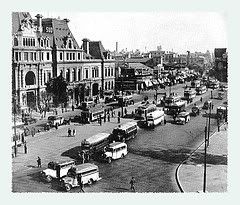
In May 2007’s issue of tango magazine El Tangauta, I finally found the last piece of the puzzle of a song that has special meaning for me.
In an article on Page 40, Tres Esquinas is translated as “Three Corners’. What does the name means? I found out that Tres Esquinas was the name of a station of a train line that no longer exists today in Buenos Aires.
The song Tres Esquinas first came upon me in the tango documentary “Tango, Baile Nuestro” by Jorge Zanada. I have been dancing tango only a few months then, and have no idea what was the name of the song. The grand orquesta of Angel D’Agnostino y Angel Vargas meant nothing for a while yet. Those marvelous revelations came later. What I knew was that the song was beautiful and echoingly evocative. It occupies a special place in my heart. Until today it never fails to struck a deep chord within me.
I watched “Tango, Baile Nuestro” over and over, rewinding continuously to the scenes with clips of social dancing in Buenos Aires circa early 1980s. That is a story for another time perhaps. In one of the scenes, Tres Esquinas was the song playing when the veteran portenos danced around a big dance floor resembling a basketball court. This is of course Club Sunderland, the milonga located in the barrio of Villa Equiza in Buenos Aires. Music and its associations with our memories have great evocative powers. At any time, no sooner do I hear the melodic opening of Tres Esquinas, am I transported to another time and era.
“Yo soy del barrio de Tres Esquinas, Viejo baluarte del arrbal…”
(I am from the neighborhood of Tres Esquinas, old bulwark of the suburbs…”)
The sweet, sweet soaring strains of violins playing the refrain followed by the echoingly notes of the piano brings an upwelling of emotions and moisture to the eyes. The tears do not fall because this song is redolent of nostalgia and not heartache. Nostalgia is a quality of longing for those times past, often tinged with regret, yes, but with the air of acceptance. Who else has any other choice but to accept the past? We look back at the past as if watching images flashing silently past on the surface of an old mirror, the fleeting images indistinct and yellow with age. The pang will always be there. The rest has dissolved into a million shimmering pieces, long since seeped away with time.
Before the turn of the twentieth century, the last train left from the Tres Esquinas station and by middle of the century, the station was demolished.
El Tangauta’s article put it well. The tango remained.
Footnote: Tres Esquinas station was located at Paseo Colon y Venezuela in today’s area of Monserrat in Buenos Aires.
In an article on Page 40, Tres Esquinas is translated as “Three Corners’. What does the name means? I found out that Tres Esquinas was the name of a station of a train line that no longer exists today in Buenos Aires.
The song Tres Esquinas first came upon me in the tango documentary “Tango, Baile Nuestro” by Jorge Zanada. I have been dancing tango only a few months then, and have no idea what was the name of the song. The grand orquesta of Angel D’Agnostino y Angel Vargas meant nothing for a while yet. Those marvelous revelations came later. What I knew was that the song was beautiful and echoingly evocative. It occupies a special place in my heart. Until today it never fails to struck a deep chord within me.
I watched “Tango, Baile Nuestro” over and over, rewinding continuously to the scenes with clips of social dancing in Buenos Aires circa early 1980s. That is a story for another time perhaps. In one of the scenes, Tres Esquinas was the song playing when the veteran portenos danced around a big dance floor resembling a basketball court. This is of course Club Sunderland, the milonga located in the barrio of Villa Equiza in Buenos Aires. Music and its associations with our memories have great evocative powers. At any time, no sooner do I hear the melodic opening of Tres Esquinas, am I transported to another time and era.
“Yo soy del barrio de Tres Esquinas, Viejo baluarte del arrbal…”
(I am from the neighborhood of Tres Esquinas, old bulwark of the suburbs…”)
El Tangauta
The sweet, sweet soaring strains of violins playing the refrain followed by the echoingly notes of the piano brings an upwelling of emotions and moisture to the eyes. The tears do not fall because this song is redolent of nostalgia and not heartache. Nostalgia is a quality of longing for those times past, often tinged with regret, yes, but with the air of acceptance. Who else has any other choice but to accept the past? We look back at the past as if watching images flashing silently past on the surface of an old mirror, the fleeting images indistinct and yellow with age. The pang will always be there. The rest has dissolved into a million shimmering pieces, long since seeped away with time.
Before the turn of the twentieth century, the last train left from the Tres Esquinas station and by middle of the century, the station was demolished.
El Tangauta’s article put it well. The tango remained.
Footnote: Tres Esquinas station was located at Paseo Colon y Venezuela in today’s area of Monserrat in Buenos Aires.
